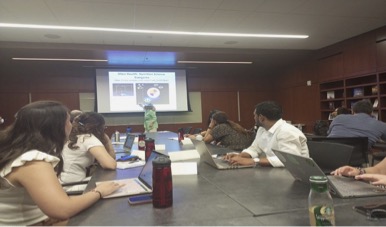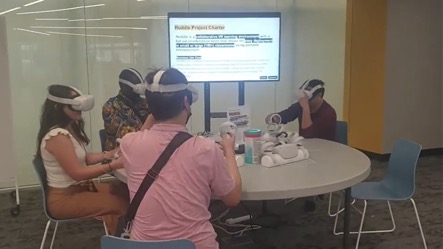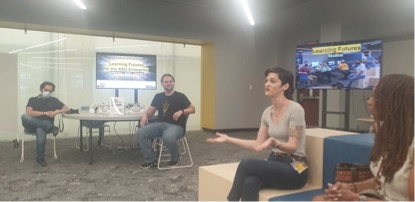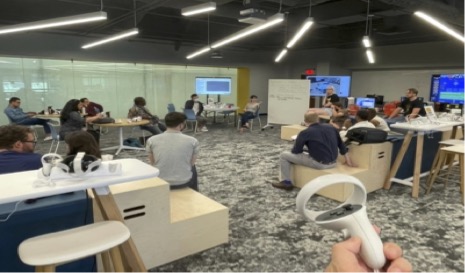This was a day with overwhelming experiences on immersive media. It was filled with excitement, and a chance to really let our imagination flow. We were introduced to the basics of immersive worlds, going beyond reality to explore the spectrum of augmented reality (AR, “overlays on the real world”), mixed reality (MR – “interactive often with tangible hand-manipulated objects; some of the world is real, some is digitized”), and virtual reality (VR – “surrounded 360 degrees by a digitized world”). And why not!
The day started with a session by Dr. Mina C. Johnson-Glenberg, a Research Professor in the Department of Psychology at the Tempe campus of Arizona State University. Professor Glenberg, also the President of Embodied Games, LLC, introduced us to the immersive technology of extended reality (XR). Immersive is a buzzword that can be understood as a situation with extended reality along the technological landscape. Immersive technology spreads across the spectrum of AR to MR to VR. It allows users to interact virtually with different types of content and with an extended feeling of emotions. Importantly,
Professor Glenberg helped us to dig deep into the applications of XR, particularly in the arena of education. Immersive technology like VR would be more effective for educational designers. With the help of XR, they might deploy learning tools and content more interactively and effectively. Therefore, learners would not be merely passive participants in the learning process. If educational content including videos, audio-visual materials, and text is combined with immersive technology, participants would be able to engage with the content more directly. Notably, learners would have higher expectations. They could do more rather than merely navigating content. They could handle the content, hold the controller, and even interact with the material.
Moreover, the uses of VR seem to be indispensable in some situations. For example, using VR, we can change the color of the embodiment used in some contents. VR could be applied to represent some impossible things like flying scenarios of a house or school or market. Sometimes, dangerous events such as an emergency exit from a train or plane, or a view of deforestation could be represented via VR. Sharing experimental research findings, Dr. Glenberg also discussed how the use of immersive technology could affect gains in learning outcomes.

From a journalistic point of view, immersive technology would assist in representing journalistic content in more interactive ways. News stories including health-related issues, development news items, stories on nutrition science, and environmental reports could be represented in outstanding ways with the uses of AR, XR, and VR. These would also be well suited for presenting news of any accident or dangerous situation or sensitive case. News audiences also could receive first-person experiences of daily events and the situations they come across through news stories. In particular, VR will allow audiences to experience virtually created situations embodied in the news stories. The application of immersive technological tools in the news stories will likely help to audience learning. News users would see the message, read media content, participate in the content and obtain civic awareness.

Taking all the aforementioned potential benefits of immersive technologies into account, we came into contact with the most exciting part of experiencing virtual reality (VR) in the Learning Futures Collaboratory (LFC) at ASU. On arriving at the LFC, we forgot for a while about our existence of living in the real or the virtual world! The reason was simply experiencing VR by using 3D tools on desktop computers and through VR headsets. The LFC is a center of excellence for innovation, creativity, entertainment, and new application, run by a team made up of energetic, multidisciplinary, creative, visionary, and dynamic members. It reminds one of the very spirit of ASU’s dedication to innovation. The LFC contributes to supporting classroom learning with its innovations.
SUSI scholars also underscored how VR brings revolutionary changes into the fields of entertainment, storytelling, learning tools, and virtual deliberation, among many others in the interactive session led by Olivia Hernández, creative manager of the LF emporium. Participants shared their views on the usefulness of VR particularly in raising public awareness, changing positive mindsets, conveying development communication messages effectively, and more.

However, questions were raised about the uses of immersive technology for journalistic content. Since journalism observes strict rules about facts and objectivity, does the use of VR or AR for news stories somewhat distort its core values and principles? How do we separate facts from embellishment? These arguments were also refuted, as others claimed that the use of immersive technology in news content, with the glamour of XR, AR, and VR, would instead help bring users out of monotony. Applying immersive technology may be a key way of making media usage enjoyable. Only the use of technology could better represent grounded stories, historical legacy, and the suffering of a community or its people empathically. Through an immersive system of representing journalistic content, people could experience scenarios and sounds for themselves, coming closer to the feelings and emotions of the people covered in the news. News audiences could then empathize more with the people shown in news stories. This might drive news users to be more active in bringing about positive changes in society.
